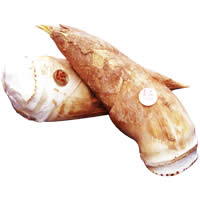京都府の農業

京のブランド産品
京たけのこ Kyo Bamboo Shoot 京冬筍

1654年、宇治黄檗山万福寺に明国の僧・隠元が孟宗竹の母竹を携えて来日し、これが西山の麓一帯に定着したという説と、唐に渡っていた禅僧が持ち帰り、長岡京市の奥海印寺辺りに植えたのが広まったとの2説があります。 えぐみがなく、軟らかく甘味がある日本一の誉れ高い京たけのこは、並々ならぬ栽培農家のたけのこ畑管理から生まれます。施肥、土入れ、親竹の間伐など、すべて農家の手作業で行われるのです。 桜のつぼみが脹らみだす頃、いまも京都西山一帯は「朝堀りたけのこ」ののぼりでにぎわいます。
There are two theories about the origin of the bamboo. The theory established at the foot of Nishiyama, says that Ingen, a monk from the Ming Dynasty, brought back the mother bamboo of “Mousoudake” (Moso Bamboo), when he visited Manpuku Temple on Mt. Obaku in Uji, in 1654. The other theory claims that a Zen priest was abroad in China during the Tang Dynasty, and had brought it home and planted it near Okukaiinji Temple, in Nagaokakyo. Without any acridity, the soft and sweet tasting bamboo shoots of Kyoto are ranked the highest in Japan. They are produced from bamboo fields, which are managed exclusively by bamboo specialist farmers. The fertilization, soil placement, bamboo thinning etc. are all carried out manually by the farmers. When the cherry blossoms are in full bloom, the whole Nishiyama area becomes filled with sprouting bamboo shoots. You can find banners with “Morning Harvest Bamboo Shoots” written on them, attracting crowds of people waiting to buy their fresh bamboo shoots, for they are dug up early in the morning.
1654年點由中國・明代僧侶隠元,將孟宗竹的母竹攜至日本宇治黃檗山萬福寺內,這便是京冬筍會在西山山麓一帶扎根的說法。還有一說則是認為京冬筍是由遣唐的禪僧所帶回,並於長岡京市的奧海印寺一帶進行種植,近而廣傳開來。被讚譽為日本第一的京冬筍,不但沒有苦澀味,還有著香甜柔嫩的口感,只有苦心栽培的農家所播種的農田,才有辦法栽種出來的品種。施肥、填土、砍竹等作業,全部都依靠農家的雙手來細心照顧。在櫻花花蕾準備綻放的同點,現在京都西山一帶也因「清晨採筍」這樣的登山活動而熱鬧著。
